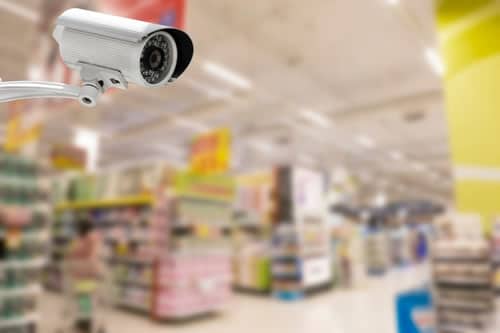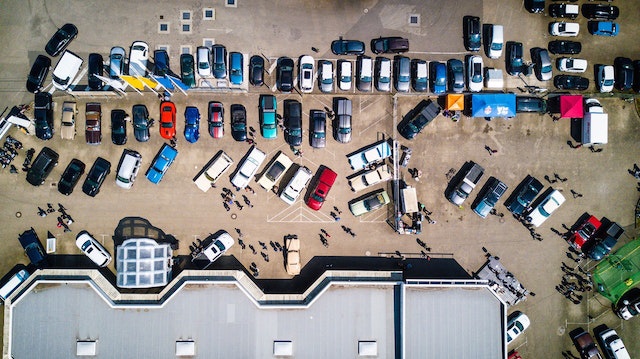From Robots to Flying Cameras: 5 Technology Innovations for Improved Facility Security

Ensuring the security of your business is a key component of facilities managers’ jobs; your facility needs to be safe for operations to function properly and for customers to enjoy their experiences. Security solutions used to be fairly outdated, with stagnant surveillance cameras and guard patrols being the only widespread options. Now, however, new facilities management technology is springing up that can optimize how businesses keep their facilities safe.
Let’s take a look at five of the most innovative technology solutions changing the way FMs approach security:
1. Surveillance Robots
Mention surveillance robots and most people immediately think of the RoboCop films. While this is certainly an intriguing concept for improving facility security, real-life surveillance robots are more like unmanned ground vehicles than reincarnated police officers made of metal.
Facility guard tours are a monotonous task, which increases the chance that boredom or fatigue causes a security threat to slip through the cracks. One of the core benefits of employing a surveillance robot is removing the possibility of human error. Surveillance robots can be equipped with specialized sensors for detecting a wide range of disturbances, like unauthorized vehicles or unplanned internal temperature fluctuations. Robots can also be equipped with emergency call buttons so that they can alert human facilities staff if anything is awry.
One company that has seen early success with surveillance robots is Microsoft. Microsoft started with a robot surveillance program in their Washington headquarters, and have since expanded the program to its other locations. Most easily quantifiable are the financial benefits of surveillance robots; Microsoft reported that it had to pay human security guards nearly twice of what it costs to utilize robots.
2. Drones
Drones are unmanned aerial systems that are especially useful for monitoring the outside areas of facilities. Compared to fixed surveillance cameras that can only monitor one specific area, drones are highly mobile and can pivot, dip, rise and move to oversee much larger areas. Drones can also be used as first responders to security incidents. They appear on-site quickly, often beating human responders and immediately provide video, audio and other sensory information about the incident. With this information, facilities managers can make smart decisions about what kind of response they need to deploy.
Drones can also be used as first responders to security incidents. They appear on-site quickly, often beating human responders and immediately provide video, audio and other sensory information about the incident. With this information, facilities managers can make smart decisions about what kind of response they need to deploy.
Another security aspect to consider is if your facilities are protected against unwanted drone presence. Do you have a system for detecting external drones in and around your facilities? Facilities that require heightened security, such as government campuses, need to be aware that drones could be used to penetrate their privacy. If your facility needs to be secure, make sure you have a process in place for handling unwanted drone activity.
3. Intelligent Video Monitoring

Video monitoring is a tried and true method to improve facility security. However, new updates can enhance video monitoring and make it an even more effective security system. New software technology enables smart video monitoring, meaning that video is analyzed and can issue alerts if out-of-the-ordinary events are taking place. Smart video monitoring can be programmed to send out alerts about specific instances, such as glass breaking or an unauthorized person in a secured area.
4. Movement Tracking
Knowing who is coming in and out of your facilities and when is vital to ensuring your security. There are several technology innovations that help accomplish this:
GPS and IVR Contractor Check-In and Check-Outs
Contractors are authorized to enter and exit your facilities, but you need to know exactly which ones are moving through your locations at any given time. To monitor contractor movements, you can employ GPS and interactive voice response (IVR) software that tracks which contractors are coming in and out of your facilities.GPS check-in validates contractor presence at your location via mobile GPS tracking and provides you with real-time updates with their location. IVR check-in utilizes a call system— contractors call upon arrival at the site and enter a PIN and work order number. Upon check-out, they follow the same process and can also add notes, such as whether or not a follow-up visit is required.
Technician Identity Verification
Many companies face risks from contractors and technicians entering locations without being accurately identified or with full knowledge of their background.
Unique, computer-generated ‘badges’ with barcode identifiers allows on-site staff to verify arriving technician identity via mobile devices, and ensure that the specific person who’s supposed to be entering a facility is in fact the correct person.
Such mobile-based site access verification systems also enable local staff to know ahead of time who’s scheduled to arrive, who’s on site and even generate temporary badges for anyone, internal or third party, who needs on-site access.
Biometric Tracking
Biometric tracking involves using people’s identifying features, like fingerprints or irises, to check in and out of facilities. This method is extremely secure, since these types of features cannot be duplicated, lost or stolen.
While biometric tracking ensures enhanced security, it can be expensive to integrate into your existing facilities security processes. Additionally, biometric security measures can slow down operations, as scanning databases of thousands of fingerprints or iris patterns can take some time. This additional time can add up quickly and decelerate operations.
Smart cards can help alleviate this – they include magnetic strips that can store an individual’s biometric information. This can speed up biometric identification, since users need to swipe a card rather than wait for their fingerprint to be scanned.
Many businesses are utilizing multiple movement tracking strategies to enhance their facilities’ security. Most effective is a three-step identification process: a biometric element, a smart card and a password.
5. Security Analytics
Analytics have many uses, and an often-overlooked one is security. FM analytics can comb through facilities data to derive insights, trends and outliers that help you identify ways to reduce security costs or make improvements.Additionally, with analytics you can easily keep track of how your security technology is functioning and address repair or maintenance if necessary. For example, if your alarm system is starting to fail due to age, you can use analytics insights to determine whether it makes sense to repair the existing alarm system, or whether purchasing a new one would save you money and improve security in the long run.
Final Thoughts
When you prioritize facility security, ultimately you are helping to improve customer experiences and revenue at your business. When employees feel safe, they are able to be productive and serve customers to the best of their abilities. With a more secure location, customers are encouraged to spend more time and money at your business. By investing in security, you invest in the health and happiness of your employees and your customers, driving revenue and nurturing loyalty.
Learn more about how facilities management technology can help your business optimize every area of your FM processes, from security and beyond.
Aerial Photo by Stephan Müller from Pexels



